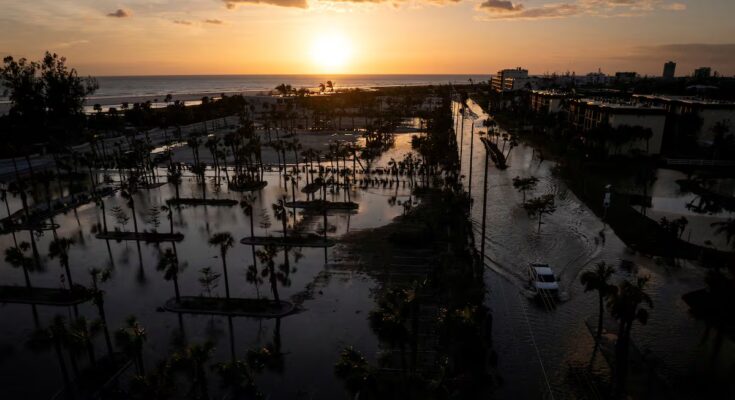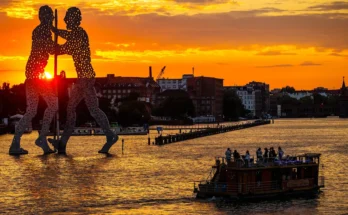In Miami Beach the debate is no longer about whether the climate crisis will arrive, but rather how to live with it. In this coastal Florida city, where flash floods are no longer a seasonal phenomenon but an increasingly common nuisance, climate change is experienced as an everyday emergency. A CLEO Institute study predicts that by 2100, large areas of Miami could be permanently submerged if sea levels rise by 6 feet, the city’s average elevation.
“If our elevation is above six feet and is expected to rise by the same amount, you don’t have to be a scientist to know that much of Miami will be flooded,” explains Yoca Arditi-Rocha, director general of the CLEO Institute.
Added to this is a less visible but equally serious problem: the porosity of the soil. “Sea levels are permeating the water table and impacting our water security because the city of Miami’s drinking water comes from the aquifer beneath us, causing it to mix with the salt water in the Miami aquifer.”
Given this diagnosis, it becomes evident that “climate change is no longer a future threat, but an ongoing one.” And Miami Beach has decided to place itself at the forefront of this battle.
Ground zero of resilience to the climate crisis
In 2006, long before the climate crisis dominated headlines, Miami Beach created the Environmental Sustainability Committee. At the helm was Michael Góngora, then municipal commissioner, who recalls that the political and scientific climate was different. “There weren’t many studies on the problem yet, but it was already clear that something had to be done,” he says.
One of the committee’s first conclusions was that the city needed a flood plan. Here’s how Stormwater Master Planan ambitious program that included three pillars: raising roads, installing powerful drainage pumps and building new natural and artificial defenses.
“What we were looking for was to keep the streets dry and healthy,” explains Góngora, describing the mechanism: by raising the level of the streets, the houses are lower than the street, which allows the insertion of underground pumping systems that redirect the water more quickly.
Although the project aimed to protect the city from flooding, not all communities welcomed it with the same enthusiasm. In the early years, some of Miami Beach’s wealthier areas strongly opposed the plan. Góngora recalls that “residents panicked because they didn’t understand that the city would raise the road and that their properties would collapse,” as many feared that this new elevation would cause more problems than solutions.
“They were afraid that the water would come down and cause them to flood,” he says, though he admits that initial mistrust hindered the project’s progress and forced the city to step up communications to convince residents that water pumps and new infrastructure would avoid that very scenario.
Despite resistance from neighborhoods, the slowness of obtaining permits from the State of Florida and legal complexity, work began in 2013 and has expanded since then.
The project also included the construction of retaining walls and the restoration of dunes that serve as the first line of natural defense against rising sea levels.
Over the years, the plan stopped being a local experiment and became an example that other cities around the country are watching closely. The solutions applied in Miami Beach are now being studied in different parts of the United States as a roadmap to adapt to rising sea levels and increasingly frequent flooding.
“Miami Beach has been at the forefront of resilience planning,” says Álex Fernández, newly re-elected city commissioner. And he boasts that the Federal Emergency Management Agency (FEMA) has officially recognized the city’s progress, positioning it as a national model.
Although there are no precise figures, municipal authorities recognize that investments in resilience already amount to “hundreds of millions of dollars”, an unprecedented effort whose political impact, Góngora admits, is limited: “It is difficult to promote projects whose results are not seen in the short term and which do not generate votes.”
But the climate emergency, he warns, “does not wait for electoral cycles”.
Climate gentrification
While Miami Beach invests to combat sea level rise, another wave is silently advancing: that of climate change.
In South Florida, historically poorer areas – such as Allapattah, Little Haiti or Brownsville – are, paradoxically, on higher ground and less susceptible to flooding. This geographic advantage has become a magnet for developers and new residents with greater purchasing power.
Expensive insurance is a central part of the problem. Between 2019 and 2024, home insurance rates in Florida increased by 55%, one of the most dramatic increases in the country. And, according to data from the Consumer Federation of America, 14% of Latino homeowners and 11% of African American homeowners cannot afford homeowners insurance, compared to 6% of white homeowners.
For many owners, the decision is marked by insurance, which, “in some cases, has doubled in value in recent years.” “Many clients have come and said to me: You know what, Esteban? Let’s sell and let someone else pay,” says Esteban Reyes, a real estate specialist.
In this sense he also warns that the increase in insurance prices has a direct impact on the purchase of a house: “Depending on how expensive the insurance that the bank will require for that flood zone, this will significantly influence the purchase.”
In this regard, Antonieta Cádiz, executive director of Climate Power in Action, denounces that this is a “very unfair” situation because “millions of people will have to face what is called climate gentrification: people forced to displace due to the impact of climate change”.
Cadiz estimates that “about half of the 2.6 million residents in the Miami area will face climate gentrification in the near future.”
The circle closes when compulsory insurance becomes prohibitive for the population. “Insurers see that disasters are continuous and do not have enough resources to cover insured people. So they pass the costs on to consumers,” explains Cádiz. The result? “There are fewer people insured, and in Florida 14% of Latino homeowners don’t have home insurance. If they face a climate disaster, they lose everything.”
The Brownsville case
According to census data, between 2010 and 2020, the Hispanic and white population in Brownsville increased by 91.4 percent, while the African American population decreased by 23.8 percent. In this historically black neighborhood, developers saw an opportunity: elevated land, central location, proximity to trendy areas and still relatively affordable prices
“The innermost areas of Miami are increasing in price a lot and this means that traditional people practically can’t live there anymore,” explains Cádiz.
Thus, the communities that have occupied these neighborhoods for decades are being replaced by higher-income residents, attracted by the relative safety from flooding and lower insurance premiums. Cadiz sums it up starkly: “They are literally pushing them out because they see people with more money buying up those areas.”
Experts agree that Florida faces a historic dilemma. On the one hand, cities like Miami Beach invest billions in adaptation work, but, on the other, climate organizations warn that adaptation alone is not enough if deep mitigation measures are not applied to reduce emissions and slow the pace of global warming.
Arditi-Rocha insists that cities must balance both strategies. “Vulnerability exists and is getting worse,” he recalls. And scientific projections, including those of American scientistwhich estimates that more than half of the area’s residents could be pressured to relocate if sea levels rose 40 inches, suggesting the challenge is just beginning.
Whether or not South Florida succeeds in becoming a model of resilience will depend, in large part, on its ability not only to defend itself from water, but also to prevent its most vulnerable residents from being left out of the equation.
Because, as organizations and experts warn, the climate challenge is not only measured in millions of investments, but also in the ability of a city to protect its inhabitants.



